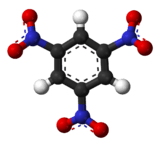1,3,5-Trinitrobenzene
 | |
 | |
| Names | |
|---|---|
| IUPAC name
1,3,5-Trinitrobenzene | |
| Other names
sym-Trinitrobenzene | |
| Identifiers | |
| 99-35-4 | |
| 3D model (Jmol) | Interactive image |
| ChemSpider | 7156 |
| ECHA InfoCard | 100.002.502 |
| PubChem | 7434 |
| UN number | 0388 |
| |
| Properties | |
| C6H3N3O6 | |
| Molar mass | 213.11 g·mol−1 |
| Density | 1.76 g/cm3 |
| Melting point | 123.2 °C (253.8 °F; 396.3 K) |
| Boiling point | 315 °C (599 °F; 588 K) |
| 330 mg/L | |
| Hazards | |
| NFPA 704 | |
| Except where otherwise noted, data are given for materials in their standard state (at 25 °C [77 °F], 100 kPa). | |
| | |
| Infobox references | |
1,3,5-Trinitrobenzene is a nitrated benzene-derivative that is classified as a high explosive, being moderately explosive in liquid form and extremely explosive in its dry powder form. It has a clear to light yellow sludgy appearance. It will detonate under strong shock. High temperatures, whether by sudden heating of any quantity, or by the accumulation of heat when large quantities are burning, will also cause detonation. The material can react vigorously with reducing materials and is incompatible with sodium dichromate or sulfuric acid.[2] It must be stored in a cool, ventilated place, away from acute fire hazards and easily oxidized materials. It also reacts violently with aluminium, boron phosphide, cyanides, esters, PN2H, phosphorus, NaCN, SnC12, sodium hypophosphite, thiocyanates, etc. When heated to decomposition it emits highly toxic fumes of NOx. It is an extremely powerful oxidizing agent which may cause violent reaction with reducing materials.[3]
Uses and applications
Trinitrobenzene is used primarily as a high explosive for commercial mining and military use. Some other uses include a narrow-range pH indicator, an agent to vulcanize natural rubber, and a mediating agent to mediate the synthesis of other explosive compounds.[4]
Safety precautions
It is recommended that people avoid contact if possible. Avoid breathing dusts, and fumes from burning or reacting material. Wear appropriate chemical protective gloves and goggles. Do not handle broken packages unless wearing appropriate personal protective equipment. Wash away any material which may have contacted the body with copious amounts of water or soap and water. Do not store near other chemicals (especially other oxidizers), near sources of heating, or places where rapid temperature changes may occur. In case of spillage immediately soak with water and carefully and slowly clean up. In case of fire let burn; DO NOT attempt to put out the resulting fire. In any case where the compound is ingested call Poison Control Center immediately.[5]
Health problems
The most common modes of exposure are either direct contact with the substance or through drinking contaminated water. 1,3,5-Trinitrobenzene is believed to cause similar health problems as TNT. Exposure to high concentrations most commonly causes anemia, or the reduced ability for blood to carry oxygen. As a result of the lack of oxygen, the skin typically becomes blue or purple in color. Other symptoms of exposure include headache, nausea, and dizziness. The long-term effects from exposure are not known because no long-term studies of health effects have been performed. It is believed that long-term exposure will cause sterility (especially in males) and cataracts. It is unknown if Trinitrobenzene causes birth defects or cancer.[6]
See also
References
- ↑ Record of 1,3,5-Trinitrobenzene in the GESTIS Substance Database of the IFA
- ↑ Sax, N. I. and Lewis, R. J. Sr. (1987) Hazardous chemicals desk reference. Van Nostrand Reinhold, New York. p. 839.
- ↑ Sax, N. I. and Lewis, R. J. Sr. (1987) Hazardous chemicals desk reference. Van Nostrand Reinhold, New York. p. 664.
- ↑ John Pike (1997-05-21). "Explosives – Nitroaromatics". Globalsecurity.org. Retrieved 2013-10-28.
- ↑ "TRINITROTOLUENE (TNT) AND TRINITROBENZENE MIXTURES [OR] TRINITROTOLUENE (TNT) AND HEXANITROSTILBENE MIXTURES". CAMEO Chemicals (Chemical Datasheet). National Oceanic and Atmospheric Administration. Archived from the original on May 28, 2010.
- ↑ "ATSDR – Redirect – ToxFAQs™: 1,3-Dinitrobenzene and 1,3,5-Trinitrobenzene". Atsdr.cdc.gov. 2010-07-20. Retrieved 2013-10-28.
